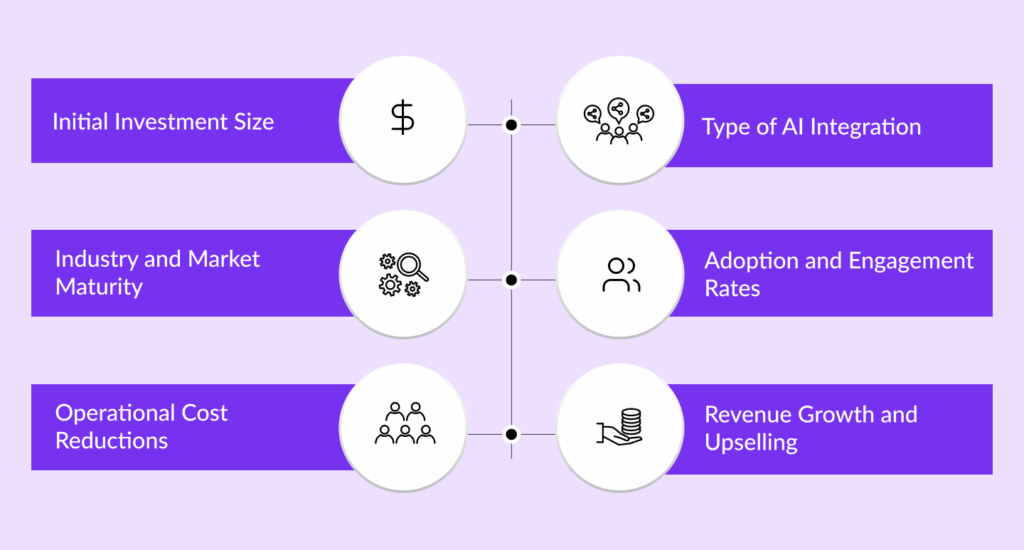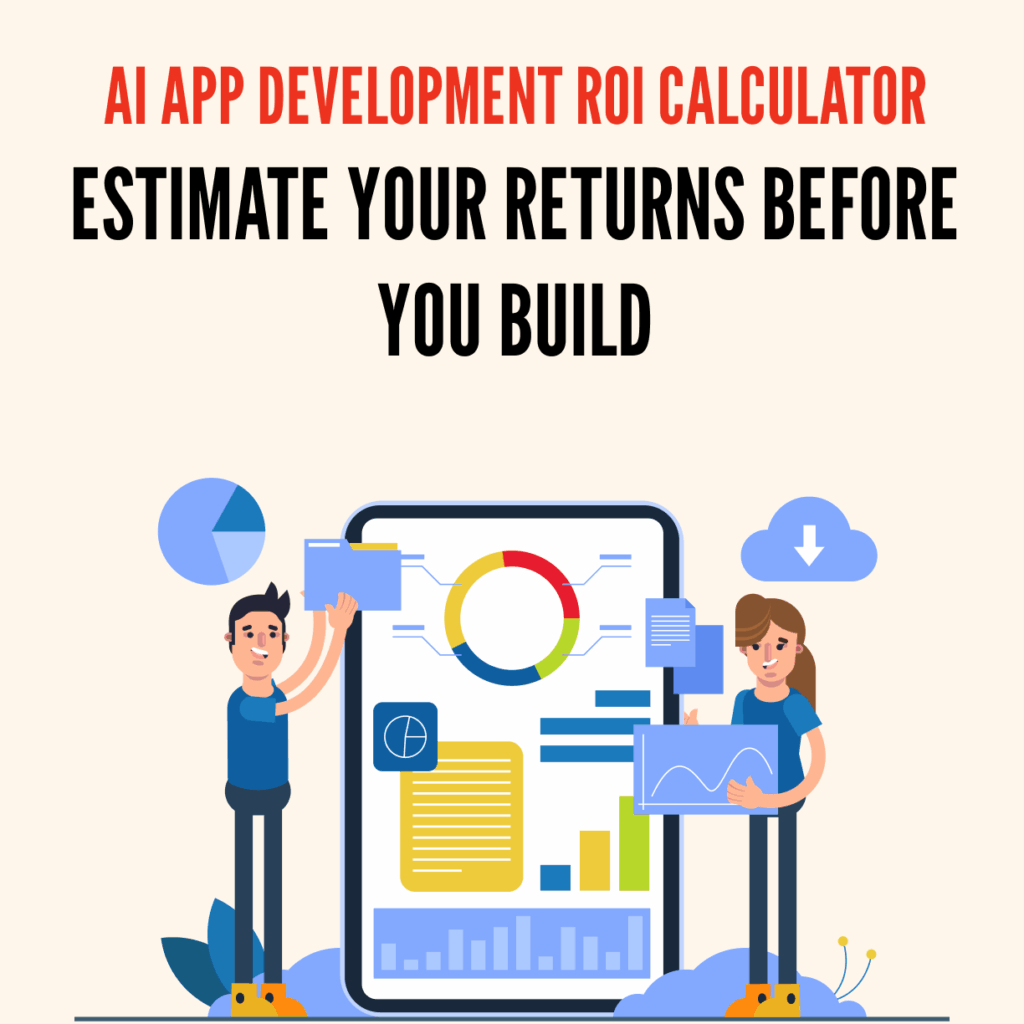|
Getting your Trinity Audio player ready...
|
The new software development backbone is Artificial Intelligence. From automating repetitive tasks to hyper-personalising user experiences entirely to uncovering other business models that never did exist, really, AI is more of a reinvention than an upgrade.
Currently, enterprise investment in AI for about 2024 has crossed $180 billion. There is really no turning back; as of today, all the founders, product leaders, and CTOs are pressured to adopt AI—not really tomorrow, but today. Building AI applications can be complex and resource-consuming. Some decisions have to be made concerning data pipelines, model training, infrastructure scaling, user experience, and regulatory compliance.
So how do you know whether your AI app idea is worth the time and money?
At this point, it becomes the calculating point of ”Return on Investment”. Absent a clear projection of possible gains versus cost, teams risk overbuilding, overspending, or building ‘stuff’ lacking in any real alignment with business objectives. Knowing your AI app’s potential ROI before writing its first line of code enables better prioritisation, stakeholder alignment, and resource allocation.
While intuition and excitement can drive a project, a data-empirical decision is more persuasive in the boardroom. An AI App ROI Calculator speaks to that. The tool provides a straight and systematic way to estimate the value an idea could generate, the time that is necessary to return the investment, and how much these returns would exceed the initial investment.
This information has become a major tool being massively used by anyone pitching to investors, convincing the executive team, or deciding whether to build in-house or outsource.
What Is an AI App ROI Calculator?
An AI App ROI Calculator is a planning and decision-support tool that outlines and quantifies the potential return of building and deploying an AI-powered application. It allows decision-makers to simulate different scenarios, weigh costs against benefits, and forecast long-term gains with higher assurance.
In some ways, your accountant may be likened to a financial clairvoyant underpinned by business logic, industry data, and the actual Key Performance Indicators of your company.
Why Businesses Need It
Unlike traditional software, AI applications have a few more variables to contend with. Among these are data readiness, model accuracy, user trust, and legal considerations. All these variables can have a giant bearing on the costs and effectiveness of your solution.
A properly structured ROI calculator can allow you to do the following:
- Validate your use case with hard numbers
- Forecast the breakeven timelines and revenue projections
- Compare AI solutions against manual processes or legacy systems
- Identify cost-saving opportunities through automation
- Help you gain an internal buy-in from finance, operations, and executive teams
Typical Inputs Used in an AI ROI Calculator
Development Cost
Estimate the cost to build an MVP or full product, which includes R&D, design, and engineering.
Time to Market
How long will it take to deploy the solution and start generating value?
Operational Cost Savings
How much will you be saving through automation of customer support and reduction of human errors?
Revenue Opportunities
Will the AI product create a new income stream, possibly through subscriptions or upselling and retention?
User Metrics
Inputs such as projected user growth, engagement, churn reduction, or time spent in the app.
Time Horizon
Over how many months or years will the ROI be measured?
The calculator takes these variables and combines them into a model that will project when the app will “pay for itself” and what expected levels of return will occur within specific time frames.
Key Factors That Affect ROI in AI App Development

Understanding the factors that shape your AI app’s ROI is crucial. ROI isn’t static — it shifts based on how the solution is designed, deployed, and adopted.
1. Initial Investment Size
A $50K MVP targeting a narrow pain point may yield faster and higher returns than a $500K full-scale rollout that tries to solve everything at once. Starting small and scaling smart is often the key to ROI-positive AI.
2. Type of AI Integration
Different AI functions have different ROI curves:
- Chatbots and virtual assistants: Quick to deploy and show rapid savings in support costs.
- Predictive analytics: High long-term value in logistics, finance, and healthcare.
- Recommendation engines: Drive higher conversion rates in retail and media.
- Image and speech recognition: Useful in logistics, security, and manufacturing, often with longer implementation cycles.
3. Industry and Market Maturity
ROI potential can vary widely across industries:
- Healthcare: It has a huge ROI by reducing readmissions, optimising treatments, and automating diagnostics.
- Retail and e-commerce: ROI from personalisation, pricing optimisation, and chatbot support.
- Education: Gains from adaptive learning and content personalisation.
- Finance: Save on fraud detection, underwriting, and risk modelling.
4. Adoption and Engagement Rates
An AI solution’s effectiveness is directly tied to user adoption. If users don’t trust or understand the AI, its ROI will diminish. Designing intuitive, understandable AI interfaces can dramatically improve uptake.
5. Operational Cost Reductions
The most obvious ROI comes from automation. If your AI app eliminates the need for manual data entry, reduces errors, or shortens processing time, you’re unlocking recurring value.
6. Revenue Growth and Upselling
On the revenue side, AI often enables:
- Smarter product recommendations
- Personalized pricing
- Dynamic content generation
- Tiered subscriptions for AI-powered features
Each of these can boost average order value, user lifetime value, and brand loyalty.

Sample ROI Scenarios: From Theory to Reality
Let’s put some numbers to these concepts. Here are three examples of AI ROI in the wild.
Scenario 1: AI Chatbot in E-commerce
Goal: Reduce support costs and improve response times.
Inputs:
- Development cost: $40,000
- Average monthly support tickets: 6,000
- Cost per human-handled ticket: $3
- Expected automation rate: 75%
Yearly Savings:
6,000 × 12 × 75% × $3 = $162,000
ROI Year 1:
($162,000 – $40,000) / $40,000 = 305%
Scenario 2: Predictive Analytics for Healthcare
Goal: Predict patient readmissions to reduce costs.
Inputs:
- Development + integration cost: $150,000
- Readmissions/year: 600
- Cost per readmission: $12,000
- Predictive accuracy: 15% reduction in readmissions
Yearly Savings:
600 × 15% × $12,000 = $1,080,000
ROI Year 1:
($1,080,000 – $150,000) / $150,000 = 620%
Scenario 3: Personalized Learning Engine for EdTech
Goal: Increase subscriber retention through AI-generated content.
Inputs:
- Dev cost: $90,000
- Subscribers: 20,000
- Monthly ARPU: $12
- Retention boost: +8%
Yearly Revenue Gain:
20,000 × 8% × $12 × 12 = $230,400
ROI Year 1:
($230,400 – $90,000) / $90,000 = 156%
How to Build or Use an AI ROI Calculator
Whether you build or license one, a useful ROI calculator must balance simplicity and flexibility.
Must-Have Calculator Elements:
- Development Cost Estimator
The selection is based on features, tech stack, and team size. - Time to Value
When do you expect the AI to begin saving or earning? - Savings & Revenue Projections
The decision is made based on the automation rate, churn reduction, or new sales. - Maintenance & Cloud Costs
AI models need ongoing updates, retraining, and infrastructure. - Time Horizon Selector
Let users compare ROI over 1, 3, or 5 years.
Tools for Building One:
- Google Sheets/Excel: Good for internal planning and sharing
- Airtable or Glide: For light-weight calculators with a modern UI
- Web app (React + Flask/Django): For branded, interactive tools with export options
- Bubble.io or Softr: No-code platforms to build embeddable tools for landing pages
Limitations of AI ROI Calculators
While valuable, ROI calculators aren’t magic. They have inherent limitations:
1. Data Quality = Forecast Quality
Your outputs are only as reliable as your assumptions. Garbage in = garbage out. Always validate data points like CAC, churn, ARPU, and support costs.
2. Lack of Context
Calculators often fail to capture externalities: competitive moves, user trust, organisational resistance, or brand perception.
3. Fluid Market Dynamics
What if a competitor launches a similar product first? What if regulations shift overnight? ROI predictions are static, while markets are fluid.
4. False Precision
A calculator might show a projected 245% ROI, but the real number might be 190% or 310% depending on execution. Use ranges or confidence intervals, not single-point estimates.
Esferasoft’s Approach to AI ROI Forecasting & Development
At Esferasoft, we specialise in ROI-first AI development. That means before we build anything, we help you validate whether it should be built.
Our Process:
- Use Case Discovery
We map AI solutions to real business problems — not just cool tech. - ROI Modeling & Calculator Design
We build custom calculators tailored to your industry, use case, and scale. - Agile MVP Development
Lean, fast, and iterative builds to get you results sooner. - Post-Launch Optimization
AI needs nurturing. We’ll help you train, refine, and maximise your ROI over time.
Real-World Success
- A logistics firm improved delivery routing, saving $300K annually.
- A legaltech startup reduced case review time by 40% using our NLP models.
- A fintech app improved fraud detection rates by 28% — increasing customer trust and savings.
Conclusion: Build Smarter, Not Just Faster
In today’s AI-driven landscape, speed matters — but strategy matters more. The difference between a high-performing AI product and a costly misstep often comes down to how well the opportunity was understood before development began. An AI App ROI Calculator empowers founders, product leaders, and CTOs to make smart, data-informed decisions that align with real business value.
By modelling ROI early, you can prioritise the right features, secure stakeholder buy-in, and create a roadmap focused on tangible outcomes — not just technical milestones. Whether your goal is to reduce operational costs, open up new revenue streams, or enhance user engagement, ROI should be your primary focus.
At Esferasoft, we don’t just build AI — we build AI that pays off. With a proven process grounded in ROI modelling, agile development, and continuous optimisation, we help our clients launch smarter, faster, and more confidently.
Ready to validate your AI app idea before investing time and money? Let’s build the case for ROI—together. Call now at +91 772-3000-038!

